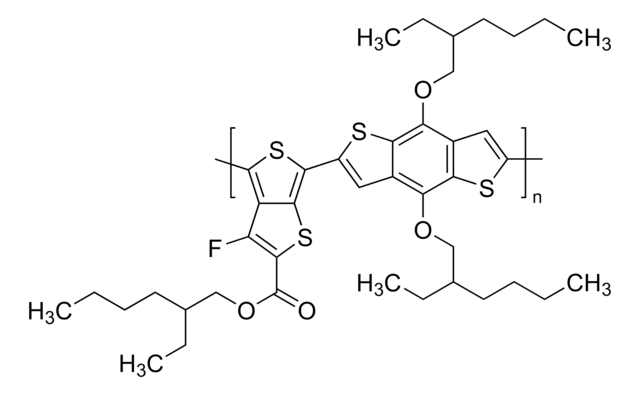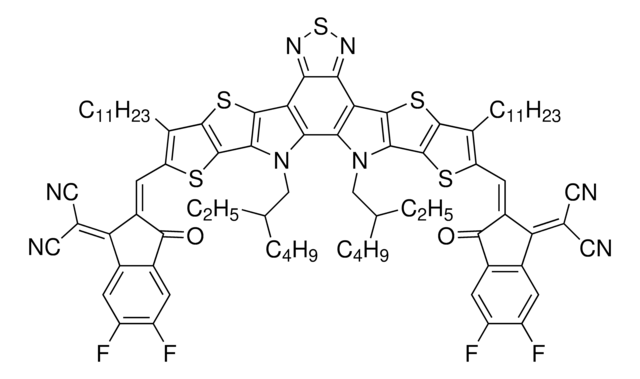Kluczowe dokumenty
753998
PCDTBT
Synonim(y):
Poly[N-9′-heptadecanyl-2,7-carbazole-alt-5,5-(4′,7′-di-2-thienyl-2′,1′,3′-benzothiadiazole)], Poly[[9-(1-octylnonyl)-9H-carbazole-2,7-diyl]-2,5-thiophenediyl-2,1,3-benzothiadiazole-4,7-diyl-2,5-thiophenediyl]
About This Item
Polecane produkty
opis
Band gap: 1.9 eV
Formularz
solid
masa cząsteczkowa
average Mw 100,000-140,000
strata
0.5 wt. % TGA, 409 °C
mp
270-300 °C
temp. przejścia
Tm >400 °C
λmaks.
576 nm
Energia orbitalna
HOMO -5.5 eV
LUMO -3.6 eV
Wydajność urządzenia OPV
ITO/MoO3-Al/PCDTBT:PC71BM/MoO3/Al
- Short-circuit current density (Jsc): 10.88 mA/cm2
- Open-circuit voltage (Voc): 0.88 V
- Fill Factor (FF): 0.71
- Power Conversion Efficiency (PCE): 6.77 %
ITO/PEDOT:PSS/PCDTBT:PC71BM (1:4)/TiOxAl
- Short-circuit current density (Jsc): 11.32 mA/cm2
- Open-circuit voltage (Voc): 0.88 V
- Fill Factor (FF): 0.69
- Power Conversion Efficiency (PCE): 6.9 %
ITO/PEDOT:PSS/PCDTBT:PC71BM/Al
- Short-circuit current density (Jsc): 9.7 mA/cm2
- Open-circuit voltage (Voc): 0.82 V
- Fill Factor (FF): 0.61
- Power Conversion Efficiency (PCE): 5.3 %
właściwości półprzewodników
P-type (mobility=6×10−5 cm2/V·s)
Szukasz podobnych produktów? Odwiedź Przewodnik dotyczący porównywania produktów
Opis ogólny
Zastosowanie
Kod klasy składowania
11 - Combustible Solids
Klasa zagrożenia wodnego (WGK)
WGK 3
Temperatura zapłonu (°F)
Not applicable
Temperatura zapłonu (°C)
Not applicable
Wybierz jedną z najnowszych wersji:
Masz już ten produkt?
Dokumenty związane z niedawno zakupionymi produktami zostały zamieszczone w Bibliotece dokumentów.
Produkty
The development of high-performance conjugated organic molecules and polymers has received widespread attention in industrial and academic research.
Organic materials in optoelectronic devices like LEDs and solar cells are of significant academic and commercial interest.
Organic photovoltaics (OPVs) represent a low-cost, lightweight, and scalable alternative to conventional solar cells. While significant progress has been made in the development of conventional bulk heterojunction cells, new approaches are required to achieve the performance and stability necessary to enable commercially successful OPVs.
Thin, lightweight, and flexible electronic devices meet widespread demand for scalable, portable, and robust technology.
Active Filters
Nasz zespół naukowców ma doświadczenie we wszystkich obszarach badań, w tym w naukach przyrodniczych, materiałoznawstwie, syntezie chemicznej, chromatografii, analityce i wielu innych dziedzinach.
Skontaktuj się z zespołem ds. pomocy technicznej




![[6,6]-Phenyl C71 butyric acid methyl ester, mixture of isomers 99%](/deepweb/assets/sigmaaldrich/product/structures/716/624/9fb9f2f0-ae99-429f-8d3a-b12267976a4d/640/9fb9f2f0-ae99-429f-8d3a-b12267976a4d.png)



